8+ Sample Pre Construction Meeting Minutes
-
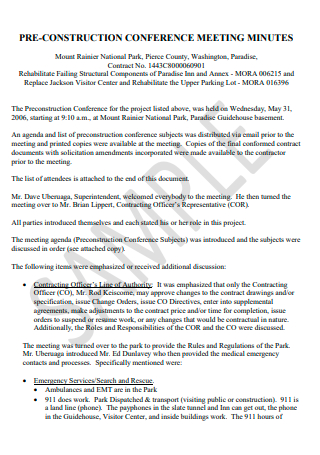
Pre Construction Conference Meeting Minutes
download now -
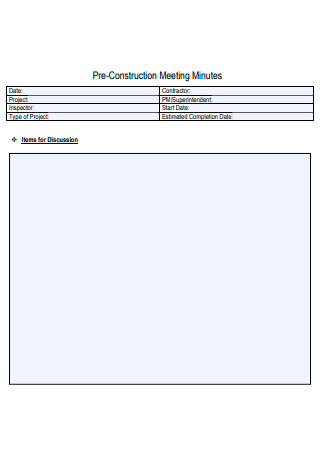
Basic Pre Construction Meeting Minutes
download now -
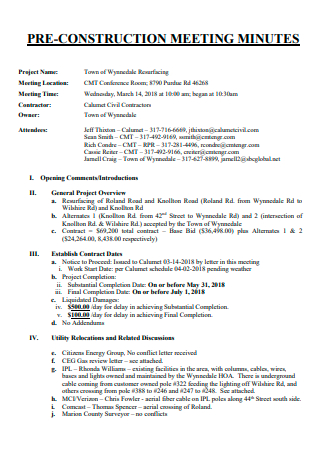
Pre Construction Meeting Minutes in PDF
download now -
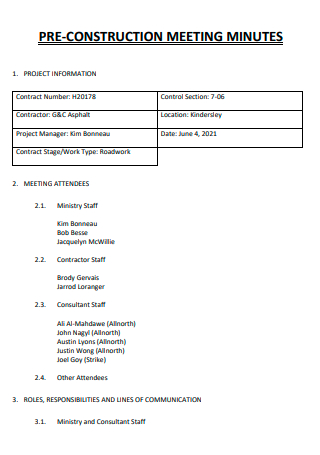
Formal Pre Construction Meeting Minutes
download now -
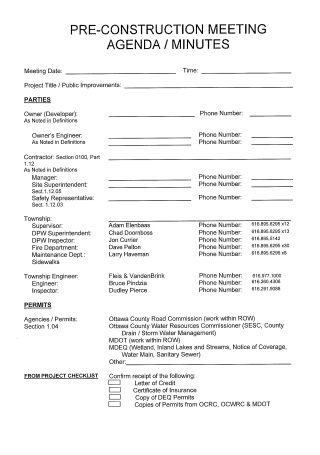
Pre Construction Meeting Agenda Minutes
download now -
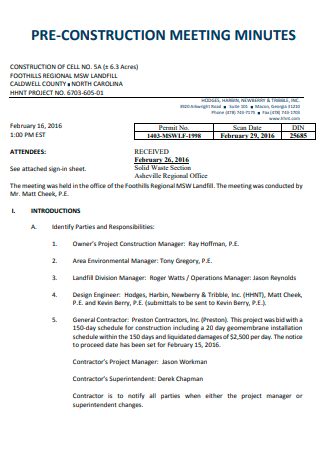
Pre Construction Meeting Minutes Example
download now -
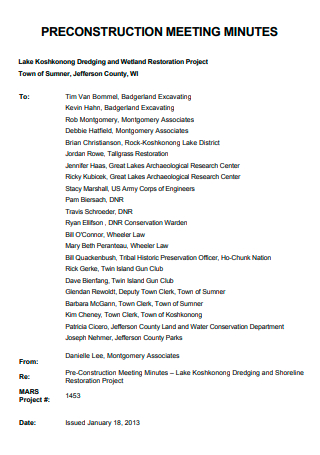
Standard Pre Construction Meeting Minutes
download now -
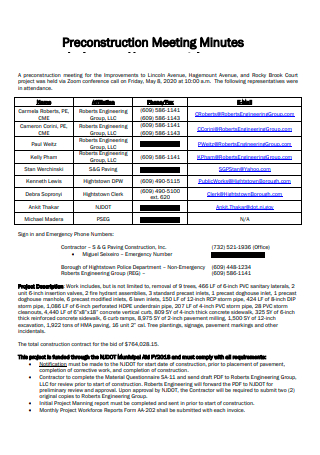
Printable Pre Construction Meeting Minutes
download now -

Pre Construction Meeting Minutes Format
download now
FREE Pre Construction Meeting Minutes s to Download
8+ Sample Pre Construction Meeting Minutes
What Are Pre-Construction Meeting Minutes?
What’s Inside a Pre-Construction Meeting Minutes?
How to Take Pre-Construction Meeting Minutes
FAQs
What tense should the meeting minutes use?
What is another purpose of a meeting minutes document?
How important is communication during the pre-construction phase?
What Are Pre-Construction Meeting Minutes?
Before we get to know the meeting minutes, first of all, what is pre-construction and what happens in it? Well, before construction begins, the client works very closely with its design team and construction partner to generate a set of precise drawings, timetables, budgets, and manpower predictions (this phase is known as the pre-construction phase). Effective and frequent communication between the core team and any extra project consultants is critical throughout the pre-construction phase of a project. An effective pre-construction phase is critical to ensuring that the project proceeds as planned, that the entire project is correctly specified, and that all prospective demands and potential difficulties of the construction project are recognized and handled.
During this phase, a series of pre-construction meetings can be held, and they are necessary since it communicates the plans and project expectations to all the key people right before the project begins. Whatever happens in the meeting, including the problems identified, the roles assigned to key personnel during the construction phase, and the key decisions that need to be taken to address any issues, are noted down in a pre-construction meeting minutes document. This is a business document that is a written record of the conversation and major decisions taken during the pre-construction meeting and is usually taken by a designated group member. The overall purpose of this document is to keep an accurate record of what happened at the pre-construction meeting. This document can also give legal protection to the construction company and also serves as proof of why certain key decisions were made.
What’s Inside a Pre-Construction Meeting Minutes?
Here are the key components that should be written down/should be present inside a pre-construction meeting minutes document:
How to Take Pre-Construction Meeting Minutes
Pre-construction meetings help the team define the project, identify possible issues and solutions, and help the team manage resources effectively. To be effective, its corresponding meeting minutes document needs to reflect the key decisions that were made throughout the course of the meeting. With that being said, here are the steps needed to effectively take pre-construction meeting minutes:
1. Pre-Planning Phase
This is the first main step of taking the pre-construction meeting minutes. During this step, if the pre-construction meeting is very well-planned ahead of time, taking down the related meeting minutes will be much easier. Additionally, during this stage of collecting meeting minutes, the chairman and scribe or minutes-recorder should collaborate to define the agenda of the meeting ahead of time. For instance, the person tasked with taking meeting minutes might collaborate with the meeting leader to create a document that would serve as an agenda and the structure for the pre-construction meeting.
2. Determining What to Write
After the pre-planning phase of taking down the meeting minutes, it’s time to proceed to this step, in which the key components of the meeting minutes need to be identified. Prior to actually entering any details, the appointed meeting minutes recorder should become acquainted with the types of information that should be recorded. The elements they must consider when recording the minutes of a pre-construction meeting include the date, time, and location of the meeting, the names of the attendees, including unavailable participants, the purpose of the meeting, the agenda of the meeting, the acknowledgment or any revisions to the preceding minutes of the meeting, the action items, additional announcements, and the specifics of the next meeting.
3. Taking Down the Meeting Minutes
After determining the key components that need to be included in this document, it’s time to actually write down the components in this step. When the pre-construction meeting concludes, the person entrusted with writing up the relevant meeting minutes should be provided with all of the tools required to write up the minutes in a straightforward, presentable manner. In the process of writing, the notetaker should not take too long to write down the minutes because everything that happened in the meeting should still be fresh in the mind, review the outline that was made previously and make the necessary adjustments, and revise the minutes when needed to ensure that they are brief but clearly written.
4. Distribution of the Meeting Minutes
After taking down the meeting minutes and making sure that everything needed has been written down, it’s time to distribute the document. Once the whole meeting minutes document has been produced, it should be shared with the company’s key people and/or the project team’s group members. When it comes to disseminating meeting papers, the procedure can be accomplished by sharing the complete document online or via the cloud. Given the amount of paperwork that minutes and other sorts of documents might involve, a paperless distribution approach may be preferable. Following that, the appointed notetaker should save a version of the meeting minutes for future reference. Again, saving a copy may be accomplished online or via the cloud.
FAQs
What tense should the meeting minutes use?
When taking meeting minutes, the scribe or designated notetaker should bear in mind that the meeting minutes must always be written in the past tense because the records are about events that transpired in the past. The past tense is not used when recording specifics about what is going to happen, such as detailing any future agendas or putting down any more announcements made during the meeting.
What is another purpose of a meeting minutes document?
The meeting minutes document can also aid the person in charge of generating the agenda, frequently the meeting chair, in finishing the following meeting’s agenda and assigning adequate time to each agenda item to guarantee a comprehensive discussion can take place. If any important concerns have been identified, or if unfinished activities have become a bottleneck for project development, they may require distinct agenda items depending on their significance.
How important is communication during the pre-construction phase?
The pre-construction phase is crucial to the success of a building project. As a result, it must largely rely on excellent communication methods. In order to have a solid baseline for good communication methods, always take the time to develop an efficient communication plan that is right for everybody, allowing everyone to engage in a way that fits their project needs. A well-communicating construction crew may assist guarantee that when challenges emerge, they are addressed effectively and promptly.
Complex projects such as construction projects require a lot of meticulous planning and brainstorming for the project to even get off the ground. As natural, during the planning phase, tons of meetings will have to take place which will determine how to manage the available resources, how to define the entire project, and what roles will the key personnel take. The key details of the meetings that have taken place will then be documented in the corresponding meeting minutes document. It shouldn’t be too intimidating to create, but should you find it to be the case, then the sample templates that are present in this article should be of great help.
